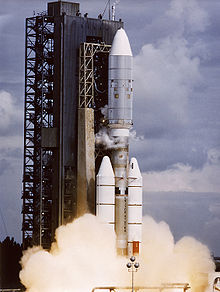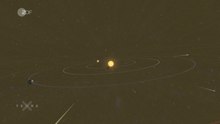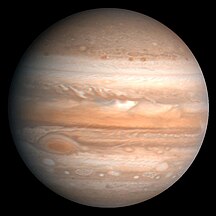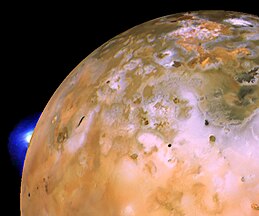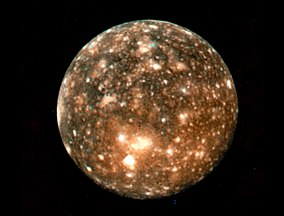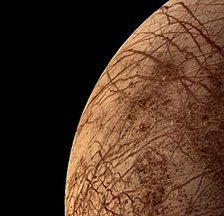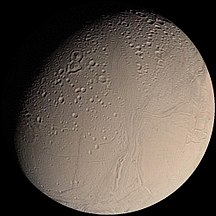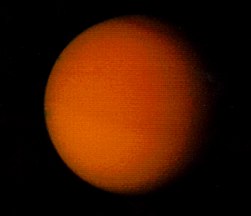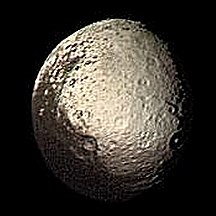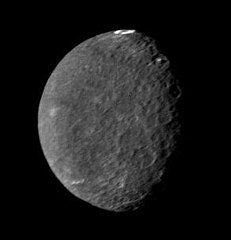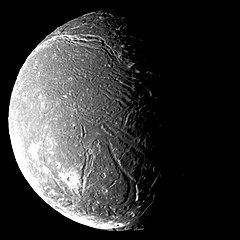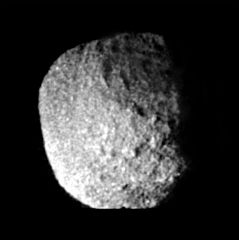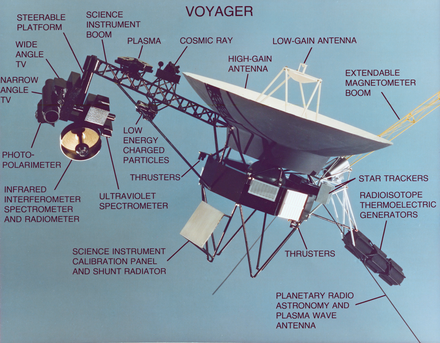Voyager 2
| Voyager 2 | ||||||||||||||||||||||||||||
|---|---|---|---|---|---|---|---|---|---|---|---|---|---|---|---|---|---|---|---|---|---|---|---|---|---|---|---|---|
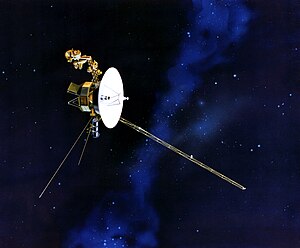 Artist's impression of the Voyager probe in space |
||||||||||||||||||||||||||||
| NSSDC ID | 1977-076A | |||||||||||||||||||||||||||
| Mission goal | Investigation of the planets Jupiter and Saturn , as well as their moons (later extended to Uranus and Neptune) | |||||||||||||||||||||||||||
| operator |
|
|||||||||||||||||||||||||||
| Launcher | Titan IIIE Centaur | |||||||||||||||||||||||||||
| construction | ||||||||||||||||||||||||||||
| Takeoff mass | 825.50 kg | |||||||||||||||||||||||||||
| Instruments | ||||||||||||||||||||||||||||
|
CRS, ISS, IRIS, LECP, PPS, PLS, PWS, PRA, RSS, MAG, UVS |
||||||||||||||||||||||||||||
| Course of the mission | ||||||||||||||||||||||||||||
| Start date | 20th August 1977 | |||||||||||||||||||||||||||
| launch pad | Cape Canaveral AFS Launch Complex 41 | |||||||||||||||||||||||||||
| End date | Scientific activities: approx. 2025, contact: 2030s | |||||||||||||||||||||||||||
|
||||||||||||||||||||||||||||
Voyager 2 ( English voyager 'traveler') is a space probe from NASA to explore the outer planetary system as part of the Voyager program . It was launched on August 20, 1977 from Launch Complex 41 on Cape Canaveral with a Titan IIIE Centaur rocket. The identically constructed probe Voyager 1 took off 16 days later on a different trajectory.
The Voyager 2 mission is considered to be one of the greatest successes for NASA and space travel in general, as the probe has far exceeded its planned life expectancy and is still regularly sending data to Earth today. On January 24, 2021, Voyager 2 is approximately 126.04 astronomical units (AU) from the Sun, or about 18.86 billion kilometers. It is the third most distant human-built object after its sister probe and Pioneer 10 .
prehistory
The roots of the Voyager program go back to the mid-1960s. There have been calculations for trajectories for probes that could take advantage of the favorable positions of the outer planets in the late 1970s. In the early 1970s it was decided to build Voyager 1 and 2. Since they were only planned as an expansion of the Mariner series, they were first referred to as "Mariner 11" and 12. This designation was later dropped due to the large structural differences between the probes. The concept phase was completed by March 1975 and construction of the probes began.
Mission objectives
The Voyager probes had no particular research focus, as there was little prior knowledge about the outer planets that could have been expanded. Therefore, the mission objectives are relatively broad:
- Investigation of the atmospheres of Jupiter and Saturn with regard to circulation , structure and composition
- Analysis of the geomorphology , geology and composition of the moons
- More precise determination of the mass, size and shape of all planets , moons and rings
- Investigation of various magnetic fields with regard to their field structure
- Analysis of the composition and distribution of charged particles and plasma
- Focused investigations of the moons Io and Titan
Course of the mission
Takeoff and flight
Voyager 2 was launched on August 20, 1977 from Launch Complex 41 of the Cape Canaveral AFS with a Titan IIIE Centaur rocket. 16 days later, its sister probe Voyager 1 also took off , but with a slightly different trajectory. Since Voyager 1 had a slightly higher take-off speed (15.0 km / s compared to 14.5 km / s), Voyager 2 was overtaken by its sister probe on December 15, 1977 at a distance of 1.75 AU .
The flight time to Jupiter was about 20 months.
Technical problems
In April 1978 it was found that communication with the probe was not working. The cause of the problem was that the ground team had not been able to communicate with the probe for a long time because the ground team was overloaded. At the same time the Galileo project was being prepared, which withdrew many resources from the Voyager program. The probe's control system interpreted the failure of the signals as a malfunction of the primary transmitter and switched to the reserve transmitter on April 5, 1978. In this one, however, a component for the automatic adjustment of the transmission and reception frequency was defective. The relative speed between the earth and the space probe fluctuated depending on where the earth was on its orbit around the sun, which led to a Doppler effect . Since the defective component no longer compensated for the frequency shifts, the wireless connection was very often broken. So a command was sent on April 6th that reactivated the primary transmitter. This had meanwhile completely failed and so the partially defective reserve transmitter had to be put back into operation. The problem of the Doppler effect was solved by calculating it in advance and then setting the transmission frequency manually. Since the Voyagers receiver only had a bandwidth of 96 Hz, the slightest deviations in the frequency generation could lead to the connection being broken. A warming of the probe of 0.25 K could cause a critical deviation, which is why temperature control was given even higher priority.
Jupiter
When Voyager 2 arrived in the Jupiter system on April 25, 1979, it replaced its sister probe Voyager 1 almost seamlessly in the exploration of the planet. Voyager 2's trajectory was chosen so that it could examine some moons from the side that Voyager 1 had hidden. The newly discovered rings and the night side of Jupiter should also be examined more closely. The moons Amalthea , Io , Europa , Callisto and Ganymede were explored , all before the Jupiter Passage. Measurements could also be carried out using the PPS instrument that had failed on Voyager 1. During the two-day primary phase near the moons and at Jupiter, the probe received continuous support from the 64 m antennas of the Deep Space Network , which enabled the maximum data rate of 115 kbit / s to be achieved. On July 9, the probe came closest to Jupiter with around 570,000 km. By the time Voyager 2 left Jupiter on August 5, it had sent 13,350 images to Earth and passed the planet at a distance of 643,000 km. The swing-by maneuver accelerated the probe to 16 km / s and was now on course to Saturn.
Saturn
The exploration of Saturn showed its very high wind speeds, especially near the equator, where Voyager 2 could measure speeds of up to 500 meters per second. These blow mainly in an easterly direction, become slower with increasing latitude and from 35 ° north / south the direction turns to west. Voyager 2 was also able to determine a very strong symmetry of the wind conditions between the northern and southern parts of Saturn, which some scientists took as an indication of currents through the interior of the planet.
Due to its trajectory, the probe was also able to examine the planet's upper atmosphere using the RSS instrument. A minimum temperature of 82 K (−191 ° C) at a pressure of 70 mbar was measured on the surface. At the greatest possible measurable depth, there was a temperature of 143 K (−130 ° C) at a pressure of 1200 millibars. Polar light- like phenomena have also been discovered north of the 65th parallel and in the UV range in the middle latitudes. The latter only occurs with solar radiation and is still a mystery, since the charged particles of the sun, at least on earth, only occur in the polar regions and not in middle latitudes.
The ice moon Enceladus
Extension of the mission
The first corrective maneuvers were carried out in the spring of 1981 in order to bring Voyager 2 to Uranus. This was not originally planned as the probe would have been on the road for 8 years upon arrival. This corresponded to twice the forecast or projected service life. Internal studies showed only a 65 percent chance that Voyager 2 would make Uranus functional. Due to the very limited computing capacity of the probe, extensive work on the ground was necessary, which cost around 30 million US dollars a year. Despite these circumstances, NASA approved a continuation of the mission, mainly because at that time there was only one other active planetary probe besides the two Voyager probes with Viking 1 .
The software had to be heavily revised. As one project scientist put it: "The probe that reaches Uranus is not the same one that left Earth." There were essentially three major problems: The extremely low data rate due to the great distance (four times lower than at Saturn), the reduced energy output of the radionuclide batteries of only 400 watts (420 watts were necessary for full operation) and the low brightness of the Uranus surface, which required longer exposure times and thus increased the risk of blurred images.
The problem of data transmission was approached from two sides: on the one hand, the data volume was reduced, and on the other hand, reception was improved. The latter was achieved by using additional receiving antennas. The telemetry was normally handled via a 64 m antenna of the DSN, which enabled a data rate of 7.2 to 9.6 kbit / s. But this was not enough to handle the large amount of scientific data involved in the Uranus passage. Therefore a further 34 m and a 64 m antenna were added so that a data rate of 21.6 kbit / s could be achieved.
On the other hand, it was possible to significantly reduce the data volume. The Golay error correction code was replaced by the more advanced Reed-Solomon method, which requires a significantly lower data rate with a similar performance. This measure alone made it possible to increase the usable data rate by 70%. However, this approach had the disadvantage that the hardware for the Reed-Solomon coding was not available twice, as was the case with the Golay coding, and thus the reliability was no longer given. Lossy compression was now applied to the very large image files, which used by far the most bandwidth. A complex process like Huffman coding could not be implemented for this due to the very limited computing and storage capacities. However, one could make use of the fact that the image area outside the planetary edges in the four corners of the image contained practically no relevant information. Instead of sending 8 bits per pixel, only 3 bits were now sent, which describe the difference in brightness from the previous point. However, for this measure, too, the failure safety had to be reduced, namely by dispensing with the reserve FDS computer, since this was now used to carry out the compression algorithms. In total, the transmission of an image from the Uranus system took 104 seconds, only 15% longer than with Saturn, at just a quarter of the data rate.
The problem of reduced power supply was countered with an energy management system in the form of a fixed schedule that stipulated when which instrument was allowed to be active. This plan was created with the help of simulations in which it was determined when which instrument was most useful. Dealing with the long exposure times, which were necessary due to the low light intensity, turned out to be more complicated. The biggest problem here was the magnetic tape, which started for the live storage of the image data at the beginning of the exposure and gave the probe a slight jolt, which led to clear streaking at an exposure time of up to 1.44 s. The aim was to compensate for this effect with the targeted use of thrust nozzles. However, they were only allowed to be operated for 5 milliseconds, which was problematic because, according to the specification, the built-in nozzles had to work for at least 10 ms in order to function properly. After the 5 ms cycle had been tested on several identical models on Earth and finally on Voyager 1, it turned out that the method could be used with Voyager 2 without any problems.
Six days before the flyby there were further problems with the transmitted images. Light and dark lines suddenly appeared in the compressed images. A full memory image of the FDS was downloaded for troubleshooting. It was found that a certain memory cell incorrectly contained a 1 instead of a correct 0 . As it turned out that this memory cell was no longer writable, the software was modified so that this memory cell was no longer used. Two days later the image system was working again without any errors.
Uranus
On November 4, 1985, Voyager 2 began observing Uranus. Before the passage of the planet, ten other, smaller moons were discovered in addition to the five previously known Uranus moons : Puck , Juliet , Portia , Cressida , Desdemona , Rosalind , Belinda , Cordelia , Ophelia and Bianca . The moon Perdita was only discovered 13 years later on the probe's images and was finally confirmed by the IAU in 2003. Their flyby of Uranus took place on January 24, 1986 at a distance of about 81,500 km. Their closest distance was to the moon Miranda with about 29,000 km. Your photos of the Uranus system ended on February 25, 1986.
Uranus in real colors
The deeply furrowed moon Miranda
The moon Umbriel
The heavily deformed moon Ariel
Preparing to explore Neptune
After leaving the Uranus system, the question of the exact trajectory that Voyager 2 should take during the upcoming passage of Neptune arose. Since no further destination was to be flown to after Neptune, there were many possible paths to choose from. Each route had its own advantages and disadvantages in terms of observation, so that the individual teams tried to find the best track for their respective department. The atmospheres department wanted the flyby as close as possible, the planetary scientists wanted Voyager 2 to be as close as possible to the only accessible moon, Triton , and the particle and radiation department preferred a more distant flyby. In the end, a compromise was agreed, which also included the newly discovered rings of Neptune. The flight route was to bring the probe up to 4800 km to Neptune and provided a passage from Triton at a distance of 38,500 km. The route was cleared in the summer of 1986, and on February 14, 1987, the thrusters were activated for an hour and a half, which finally put the probe on its course to Neptune. Since the Neptune system had hardly been explored, a set of instructions was also stored for an emergency course in case unforeseen dangers should seriously threaten the probe.
The same problem arose with the transmission of the scientific data as with the Uranus passage, whereby the distance had again increased significantly. In order to counteract the once again significantly reduced reception level due to the great distance and the weaker power supply of the probe (370 W, 30 W less than with Uranus), the reception systems on earth were further improved. This included the following measures:
- Lower noise receivers on the DSN antennas (+ 55% reception level or 3.8 dB more signal-to-noise ratio)
- Enlargement of the 64 m antennas to a diameter of 70 m
- Linking the antennas in Canberra and the Parkes Observatory
- Partly an additional 64 m antenna from the Usuda Deep Space Center
- Interconnection of the antennas from Goldstone with those of the Very Large Array
These measures enabled data rates of 19 to 22 kbit / s to be achieved. In addition, they improved the evaluation of the S-band experiment, since the reception level only fell below a critical level later, so that one could look deeper into the atmosphere of Neptune.
During the observations, the mission team had to work with even greater restrictions than with Uranus. The 30 W lower electrical power meant that even fewer instruments could be operated in parallel. In order to comply with the performance limit, the probe measured the current power consumption and switched off instruments when the limit values were exceeded. Due to the great distance, the signal transit times also increased, so that the probe had to work increasingly autonomously. Therefore, on the basis of the orbit data, which were obtained promptly in order to enable the most precise calculations possible, several command sets for the respective flight phases were created and sent to the probe.
This was mainly made possible by further doing without redundant computer systems, so that sufficient storage space and processing capacity was available for new functions. For its age and its officially projected lifespan, Voyager 2 was in remarkably good shape. In addition to the primary transmitter that failed early on, only a few memory blocks in the two FDS computers were defective and some filters on the PPS instrument had failed.
Neptune
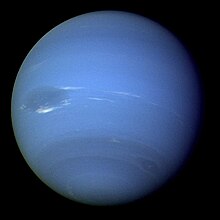
The active Neptune phase of the probe began on June 6, 1989, 80 days before the flyby. Intensive observation of the Neptune system then began two months later, on August 6, 20 days before the flyby. This took place on August 26th at a distance of 4828 km. The observation phase ended on October 2, 1989 after over 9,000 images had been transmitted.
As early as March 18th, a good three months before the active phase, intense, narrow-band radio signals could be picked up by Neptune and its internal rotation speed could be determined. During the primary phase, the rings of Neptune, whose existence could only be presumed before, could be found through very long exposures. When measuring the magnetic field, it turned out to be significantly weaker than that of Uranus.
While flying through the Neptune system, Voyager 2 discovered nine previously unknown moons. They could no longer be taken into account accordingly in the observation program, only Proteus was discovered early enough to be able to make appropriate adjustments. The previously known Triton was a focal point of the scientific mission; so its size could be determined exactly. In the literature, a diameter of 3800 to 5000 km had been assumed, but the measurements showed a diameter of 2760 km. Triton's surface showed hardly any impact craters and had a rather corrugated profile without any major height abnormalities. Brown and white appeared as the predominant colors. The latter is a result of the volcanic activity on the moon. Geysers hurl large amounts of liquid nitrogen into the air, which then partially evaporates and partially freezes out at −210 ° C and falls as white nitrogen snow on the surface. Triton's atmosphere was examined with the RSS instrument; a pressure of 1.0 to 1.4 Pa was found at ground level.
Interstellar mission
Since the Neptune Passage, Voyager 2, like its sister probe Voyager 1, has been on its way to the outer reaches of the solar system and beyond. The aim of the "Voyager Interstellar Mission" (VIM) is to explore the fringes of the solar system and the surrounding interstellar space . Voyager 2 moves at a speed of 3.3 astronomical units per year on an orbit 48 ° south of the ecliptic. In August 2007, the spacecraft crossed three years after Voyager 1, the edge of the shock wave (termination shock) and entered the " Helio envelope " (heliosheath) mentioned outer region of the heliosphere one, to solar wind and the interstellar medium mix.
From November 2018, measurement data from the plasma spectrometer (PLS) on board the probe provided indications that Voyager 2 has reached the heliopause . NASA states November 5, 2018; at this point the probe was 119 AU away from the sun.
The heliosphere of the sun, the heliopause and the interstellar space to Alpha Centauri
The probe and its scientific instruments
Voyager 2 is several meters tall and weighs around 800 kg. It essentially consists of a central, ring-shaped aluminum cell (diameter approx. 1.80 m), which is decagonal in cross-section and houses a large part of the electronics, a parabolic antenna (diameter approx. 3.6 m) and a 2.5 m long Cantilever that carries most of the scientific instruments. The energy is generated by three radionuclide batteries . Voyager 2 is identical to Voyager 1.
Current status
probe
Data (current status)
- On January 24, 2021, Voyager 2 is approximately 126.04 AU from the Sun, which is approximately 18.86 billion kilometers.
- Distance covered on November 1, 2016: Approx. 26.253 billion km = 175.49 AU
- Speed relative to the sun: 15.403 km / s = 3.239 AU / year
Data (as of January 6, 2016)
- Remaining fuel: 25.27 kg
- Radionuclide battery power: 255.8 W (about 45.5 percent power loss)
- Downlink data rate: 159 bit / s with 70 m antennas or two combined 34 m antennas. The probe is located far south of the ecliptic, so it can effectively only be observed from the southern hemisphere. This leaves only the antennas of the Canberra Deep Space Communication Complex of the antennas of the DSN for communication, possibly supported by the 64 m antenna of the Parkes Observatory .
- Due to a modification of the DSS-43 antenna in Canberra, no more signals could be sent to Voyager 2 from March to November 2020.
Mission history
Instruments
Status: 2018
| instrument | status | Remarks |
|---|---|---|
| Cosmic Ray Sub-system (CRS) | active | One of the four low-energy telescopes is defective. |
| Imaging Science System (ISS) | deactivated | |
| Infrared Interferometer Spectrometer (IRIS) | deactivated | |
| Low-Energy Charged Particles (LECP) | active | |
| Photopolarimeter System (PPS) | deactivated | |
| Plasma Spectrometer (PLS) | active | |
| Plasma Wave System (PWS) | active | Can only be used to a limited extent. |
| Planetary Radio Astronomy (PRA) | deactivated | |
| Radio Science Sub-system (RSS) | deactivated | |
| Magnetometer (MAG) | active | |
| Ultraviolet Spectrometer (UVS) | deactivated |
Voyager Golden Record
The "Voyager Golden Record" is a copper data disk that has been plated with gold to protect against corrosion . Image and audio information about humanity is stored on it. On the front there is a kind of instruction manual and a map that shows the position of the sun in relation to 14 pulsars .
Popular culture reception
Voyager 2 and its sister probe, Voyager 1 , attracted a lot of attention, especially among the general public, during their early mission phases. This is mainly due to the extraordinary mission profile (especially with regard to the distances covered) and the high quality color photos of various subjects for the time. The idea of sending a “message into space” using the Voyager Golden Record also attracted a lot of attention.
See also
literature
- Ben Evans: NASA's Voyager Missions . Springer-Verlag , London 2004, ISBN 1-85233-745-1 .
- Reiner Klingholz: Voyagers Grand Tour . Smithsonian Institute Press, 2003, ISBN 1-58834-124-0 .
- Paul Weissman, Alan Harris: The Great Voyager Adventure: A Guided Tour Through the Solar System . Julian Messner, 1990, ISBN 0-671-72538-6 .
- William E. Burrows: Mission to Deep Space: Voyager's Journey of Discovery . WH Freeman & Co. Ltd., 1993, ISBN 0-7167-6500-4 .
- Reiner Klingholz: Marathon in space: The unique journey of the spaceship Voyager 2 . Westerman, Braunschweig 1989, ISBN 3-07-509233-9 .
Web links
- Voyager project side of the NASA (English)
- Status of the Voyager probes (English)
- Images of the Voyager probes (English)
- Detailed description of the Voyager missions
- Information on the distance and direction of Voyager 2 from the sun . The table shows the year and day of the year as the date. NASA's website for data retrieval can be found here .
- Video with lots of information about contact with the Voyager 2 probe via the 70m DSS43 NASA Canberra Deep Space dish (English)
- Voyager's Journey to Infinity. Documentation from ARTE (available online until February 28, 2021)
Individual evidence
- ↑ a b Status of the Voyager space probes. On: voyager.jpl.nasa.gov.
- ↑ a b NASA query tool (English).
- ↑ Nasaspaceflight.com: Thirty-four years after launch, Voyager 2 Continues to explore , August 20, 2011; accessed on October 26, 2018.
- ^ Bernd Leitenberger: Voyager's Mission: Uranus and Neptune ; Accessed October 23, 2016.
- ↑ NASA - Jet Propulsion Laboratory : Voyager - The Interstellar Mission
- ↑ Sean Potter: NASA's Voyager 2 Probe Enters Interstellar Space. In: NASA .gov. December 10, 2018, accessed December 10, 2018 .
- ↑ Calculated from Where are the Voyagers? obtained value for January 6, 2016 and the position data of the " query tool of NASA " under the assumption that the orbit is straight so far out with good accuracy.
- ^ Deep Space Network Now. Retrieved on May 8, 2017 (constantly updated overview of the current use of the DNS antennas).
- ↑ NASA's Deep Space Antenna Upgrades to Affect Voyager Communications , JPL, March 4, 2020
- ↑ Werner Pluta: NASA can communicate with Voyager 2 again. In: Golem.de. November 3, 2020, accessed November 20, 2020 .
- ^ The Mission - Fast Facts , voyager.jpl.nasa.gov, English.
- ↑ a b NASA - Voyager Interstellar Mission 2005 ( Memento from October 16, 2009 in the Internet Archive ), (PDF; 3.7 MB); Page 3; Accessed August 19, 2018, English.


